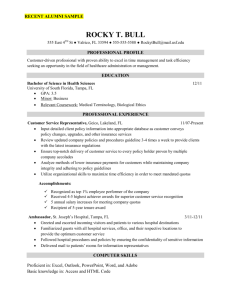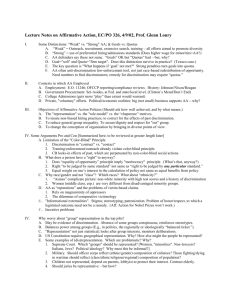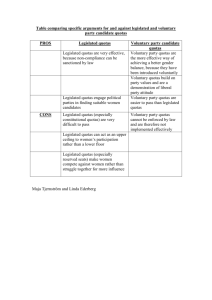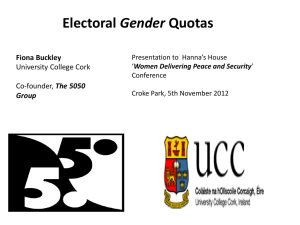PS 301 Lab—The Correspondent Inference Bias
advertisement
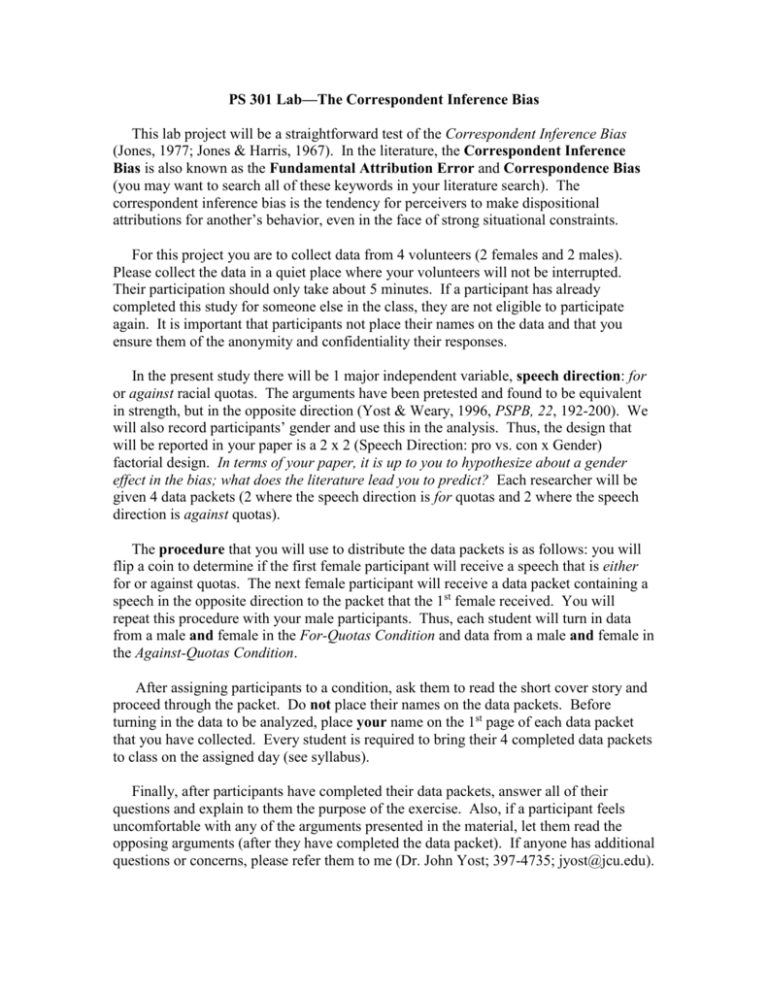
PS 301 Lab—The Correspondent Inference Bias This lab project will be a straightforward test of the Correspondent Inference Bias (Jones, 1977; Jones & Harris, 1967). In the literature, the Correspondent Inference Bias is also known as the Fundamental Attribution Error and Correspondence Bias (you may want to search all of these keywords in your literature search). The correspondent inference bias is the tendency for perceivers to make dispositional attributions for another’s behavior, even in the face of strong situational constraints. For this project you are to collect data from 4 volunteers (2 females and 2 males). Please collect the data in a quiet place where your volunteers will not be interrupted. Their participation should only take about 5 minutes. If a participant has already completed this study for someone else in the class, they are not eligible to participate again. It is important that participants not place their names on the data and that you ensure them of the anonymity and confidentiality their responses. In the present study there will be 1 major independent variable, speech direction: for or against racial quotas. The arguments have been pretested and found to be equivalent in strength, but in the opposite direction (Yost & Weary, 1996, PSPB, 22, 192-200). We will also record participants’ gender and use this in the analysis. Thus, the design that will be reported in your paper is a 2 x 2 (Speech Direction: pro vs. con x Gender) factorial design. In terms of your paper, it is up to you to hypothesize about a gender effect in the bias; what does the literature lead you to predict? Each researcher will be given 4 data packets (2 where the speech direction is for quotas and 2 where the speech direction is against quotas). The procedure that you will use to distribute the data packets is as follows: you will flip a coin to determine if the first female participant will receive a speech that is either for or against quotas. The next female participant will receive a data packet containing a speech in the opposite direction to the packet that the 1st female received. You will repeat this procedure with your male participants. Thus, each student will turn in data from a male and female in the For-Quotas Condition and data from a male and female in the Against-Quotas Condition. After assigning participants to a condition, ask them to read the short cover story and proceed through the packet. Do not place their names on the data packets. Before turning in the data to be analyzed, place your name on the 1st page of each data packet that you have collected. Every student is required to bring their 4 completed data packets to class on the assigned day (see syllabus). Finally, after participants have completed their data packets, answer all of their questions and explain to them the purpose of the exercise. Also, if a participant feels uncomfortable with any of the arguments presented in the material, let them read the opposing arguments (after they have completed the data packet). If anyone has additional questions or concerns, please refer them to me (Dr. John Yost; 397-4735; jyost@jcu.edu). Today’s study is concerned with how people form impressions of others depending on the information that they receive about a person. In this study you will read the opening arguments from a speech made during a debate by a student named Rob Taylor. Rob is a senior at his university and a member of the university debate team. In his opening remarks, Rob outlined the arguments that he would elaborate upon in his debate speech. When you are finished reading the opening arguments from Rob’s debate speech, you will be asked to answer some questions about Rob and his speech. Please do NOT place your name on the data packet. Please answer the questions at the end honestly. All responses will be kept anonymous and confidential. Thanks in advance for participating! In his opening argument, Rob stated: “The topic to be addressed today concerns whether quotas based on race should be used in future hiring and promotion decisions in the workplace. Today I will argue that the use of quotas should not be instituted for future hiring and promotion decisions in the workplace. To begin, job hiring and promotion decisions should be based solely on merit; race should not be a factor. Also, quotas, in the long run, will lead to a decrease in productivity on the job because the most qualified will not be hired and promoted. In addition, forcing racial diversity through the use of quotas may increase racial tensions in the workplace. Further, racial quotas in the workplace will lead to minority workers not working as hard because they know that they will be hired or promoted anyway. Additionally, racial inequalities in our society occurred such a long time ago; our society has already has already done enough to correct racial inequalities. Therefore, quotas are a form of reverse discrimination. Related to this, qualified people today should not have to pay for past inequalities for which they are not responsible (through losing jobs or promotions because of quotas). Finally, quota-based hiring and promotion practices may expose businesses to reverse-discrimination lawsuits.” Additional Background Information about the Speech You might be interested in knowing that Rob’s debate speech was written under the following instructions. Rob’s debate team coach assigned different team members to argue different sides of the quota issue. By the flip of a coin, Rob’s coach assigned Rob to argue against racial quotas in the workplace. In his opening argument, Rob stated: “The topic to be addressed today concerns whether quotas based on race should be used in future hiring and promotion decisions in the workplace. Today I will argue that the use of quotas should be instituted for future hiring and promotion decisions in the workplace. To begin, hiring- and promotion-based quotas are needed to help correct for any inequalities based on race that may have occurred in the past. Also, quotas will eliminate hiring and promotion advantages for those who are better qualified only because they have, based on their race, had better social and educational opportunities. In addition, quotas will make the workforce more racially diverse which lead to greater racial understanding in the long run. Further, quotas will eliminate the “glass ceiling” that exists in organizations that allows only White persons to reach top management. Related to this, quotas will enable minorities to have positions of authority within organizations and to serve as role models for other minorities. In addition, the current system is biased towards White persons and these inequalities will be perpetuated unless quotas are instituted. Finally, when quota-based hiring practices are not instituted, businesses face affirmative action lawsuits.” Additional Background Information about the Speech You might be interested in knowing that Rob’s debate speech was written under the following instructions. Rob’s debate team coach assigned different team members to argue different sides of the quota issue. By the flip of a coin, Rob’s coach assigned Rob to argue in favor of racial quotas in the workplace. I. Please complete the following general information questions: Gender: ___________ Age: ______________ II. Please answer the following questions concerning Rob and his speech: 1. What position did Rob argue in his speech? -5 -4 -3 -2 -1 0 1 2 3 4 Strongly against quotas 5 Strongly in favor of quotas 2. What do you think is Rob’s true attitude towards the issue of using quotas based on race for all future hiring and promotion decisions in the workplace? -5 -4 -3 -2 -1 0 1 2 3 4 Strongly against quotas 5 Strongly in favor of quotas 3. How much freedom did Rob have in choosing the position or side that he took in his speech? -5 -4 -3 -2 No freedom at all Thanks for participating!! -1 0 1 2 3 4 5 Much freedom
